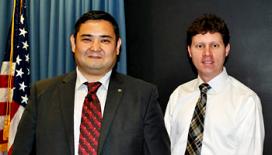A New Silk Road for the 21st Century
The 4,000-mile transcontinental trade route known as the Silk Road established connectivity between China and Western Europe beginning in 206 BC, according to Akhmed Baitassov, a Hubert H. Humphrey fellow with the Massachusetts Institute of Technology. Baitassov recently shared his perspective on a new Silk Road with staff at Volpe, The National Transportation Systems Center.
The new transcontinental route—a $7 billion, 1,700-mile highway—follows a northern route through Kazakhstan and will provide a faster and modern connection between eastern China and Western Europe. "We think it holds great promise for boosting the economy and fostering future development in the region," said Baitassov, a senior infrastructure project manager from Kazakhstan. He is participating in the U.S. State Department's prestigious Humphrey fellowship program and is completing his professional affiliation in the Center for Transportation Policy and Planning at Volpe, part of the U.S. Department of Transportation.
With leadership and support from The World Bank in Washington, the project received funding from several key financing organizations including the European Bank of Reconstruction and Development, the Asian Development Bank, and the Islamic Development Bank. "This multi-bank partnership to finance the new Silk Road, was a major breakthrough in financing, and the banks worked together to develop financing strategies in many countries," said Baitassov. The World Bank saw a unique opportunity to further its central mission of providing financial and technical assistance to developing countries.
While delays have been encountered, the new Silk Road is scheduled to open in 2015. "Securing right-of-way along the route, was very challenging and time consuming, " said Mr. Baitassov, "but the decision to build a road that involves so many countries is a good opportunity to work together for a better future in our region. We are hopeful that this will serve as a model for future development."

Akhmed Baitassov (left), a visiting Hubert H. Humphrey fellow, is completing a six-week professional affiliation and working with Eric Plosky in Volpe's Center for Transportation Policy and Planning. (Volpe photo)
